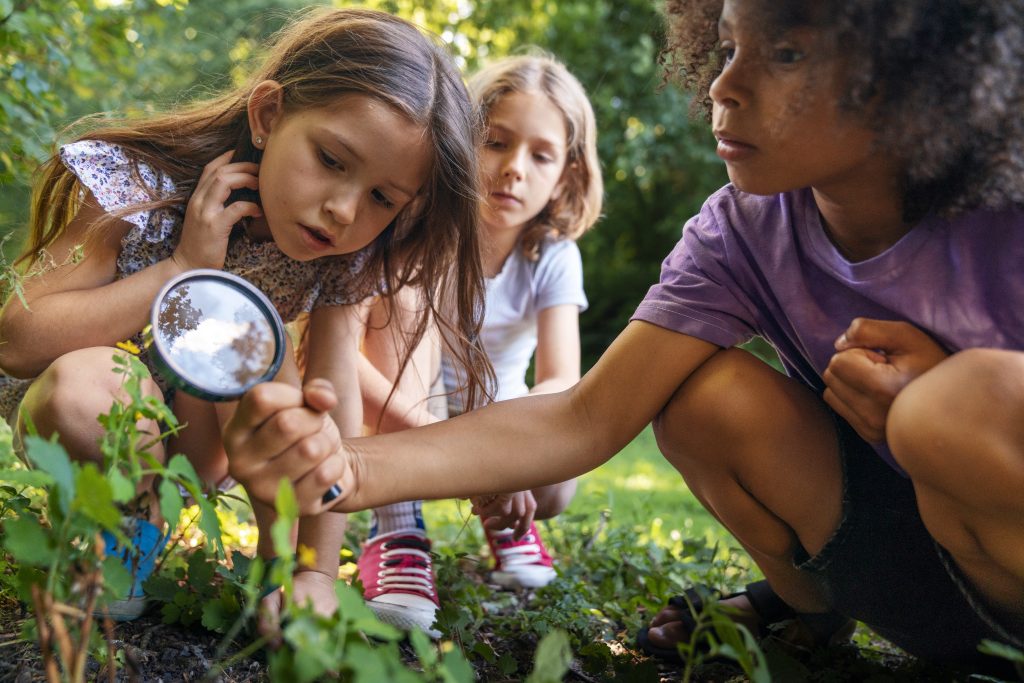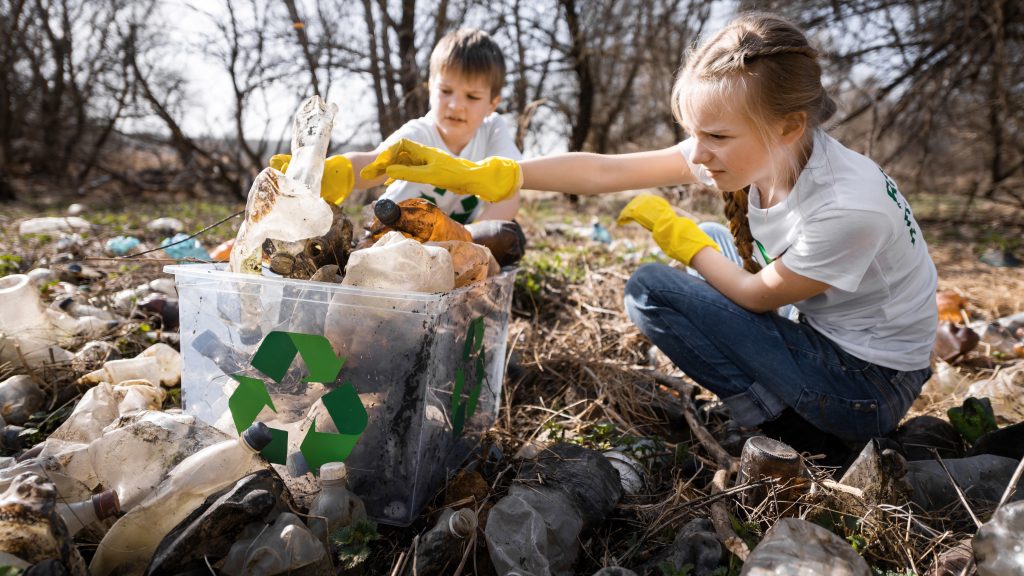Environmental education emerged in the 18th century when Jean-Jacques Rousseau emphasise the importance of studying the natural environment. Jacques later inspired a naturalist Louise Agassiz, who encouraged students to study nature, rather than studying books. This led to the evolution and development of environmental education.
Moreover, the popularity of environmental education became significant in the 1960s to 1970s. It’s at this moment, that they accept that the government can’t resolve complex global wicked problems, such as environmental degradation. In fact, environmental degradation is caused by people’s past overuse of resources, agricultural practices, and urban development. Today, environmental education extends beyond environmental degradation. It focuses more on global climate change, sustainable development, nature conservation, biodiversity, and ecology systems.

A laptop in a forest. Source: Pexels.
What is Environmental Education?
Environmental education is training an individual to learn, gain knowledge, and understand environmental matters in their location. This helps them act collectively or separately to address environmental issues. The goal of environmental education is to increase knowledge, awareness, and skills on environmental challenges for individuals, communities, and countries. This enables them to participate in activities, initiatives, or programs aimed at protecting or conserving the environment.
How to teach Environmental Education?
Transferring environmental education to children and adults occurs through different forms. Therefore, teaching might involve:
- Classroom Education: This involves education given in classes at school. Furthermore, it involves education to gain knowledge and be aware of environmental problems globally and in one’s country. Additionally, gaining environmental education knowledge consists of reading books or participating in environmental debates.
- Experiential/Practical Education: is outdoor education. It involves practical physical activities, such as nature walking or hiking, field trips to botanical gardens, and visiting nature centres. Moreover, camping is another alternative activity that allows individuals to connect with nature. People do this by staying off-grid and avoiding the use of electronic devices. This type of education allows individuals to connect classroom theory to the real environment. It leads them to see how the forces of nature influence human movement, habits, economic, and political circumstances.
- Action and Advocacy: consists of being an activist or ambassador for environmental justice. Equally important is taking action by being part of a nature conservation club or a Keep Our Cities Clean initiative. This is where you keep local parks clean and plant trees to release more oxygen into the atmosphere.

Today, environmental education is taught via the use of technological platforms. This involves creating awareness using digital campaigns, TV commercials, and media engagement. Additionally, environmental podcasts, blogs, games, or quizzes teach environment education effectively in the digital realm. During the COVID-19 pandemic, people could take virtual tours to visit places.
Ideally, most countries offer environmental education at tertiary level. However, some secondary and primary institutions provide natural environment studies at an earlier stage. This is good, as it provides knowledge at an early age of environmental education. Furthermore, kids will know if this is the career that they would like when they grow up.
Why Is It Important To Teach Environmental Education?
Environmental education helps individuals learn how nature works and how it impacts their environment. It aids them in making eco-friendly product choices and guides them toward conscious responsible consumption. Environmental education is also important because it benefits industries such as agriculture and healthcare. The healthcare sector can study environmental education to help prevent diseases. Environmental education is a huge contributor to the agriculture sector. This is because weather patterns and conditions determine if farmers will produce enough food to feed the population. Many businesses, such as restaurants, will face impacts as they rely on farmers’ produce. To help with climate change it will be best if these businesses serve what is in season.
Environmental education helps people deal with and adapt to severe weather conditions. For example, if a community loses houses due to floods or bushfires. Therefore, the knowledge gained from severe weather damage promotes the construction industry to build robust weather-resistant homes. For instance, using fire retardant paint helps prevent bushfires from burning down homes, and an open web wood truss can help eliminate mold from flooding, which erodes the foundation.
The benefits of learning environment Education
Environmental education shapes an individual’s consciousness. Indeed, environmental education has a vast number of benefits for people of all ages. Furthermore, governments and nations can take advantage of this education. These are:
Promote Mental Well-Being And Overall Human Health
Today, many people of all ages are always indoors, glued to their electronic devices. As a result, being at one with the natural environment can pose great benefits for all.
- It helps clear and declutter the mind by filling it with positive thoughts.
- It reduces stress and leaves one more relaxed.
- It helps with mental and physical drain and fatigue.
- It improves mood and concentration.
- It reduces the risks of getting sick or ill.
Thereby, this contributes to the overall physical, spiritual, and psychological well-being of children and adults. It also helps children in social interactions and physical and cognitive development.

Ignites One’s Imagination And Creative Ability
Environmental education, especially outdoor education can spark creativity and heighten imagination. This is because once one interacts with nature one gets a sense of curiosity on how things work. This leads them to creative thinking or having creative innovative ideas. Sometimes innovative business ideas that will help solve national or global problems, arise from these experiences. This normally involves having visuals (i.e. seeing the images of your ideas).
Allows Individuals Access To Quality Environmental Education
Environmental education helps individuals and communities remain aware of their natural environment. This is so that they take a stand to protect their environment by conserving it and preserving its natural resources. Knowledge or skills acquired via environmental education, help solve complex global issues and build a sustainable world through responsible consumption. For this reason, well-informed communities in environmental matters, aid governments globally to accelerate climate change targets faster.
Environmental knowledge helps young people understand where they live and provides them context in how they use nature. It helps them understand how processes operate in society and the impact of certain behaviours on the world overall. For example, it assists them in understanding waste disposal, recycling, sewerage processing, landscaping, land reclamation, erosion, pollution, etc.
Helps Protect The Environment And Promote Sustainability
Developing environmental knowledge encourages each and every individual person, or group, to include sustainable practices in their daily life. Actions range from picking up litter, recycling, and eating less animal-based products to walking, cycling, and buying local eco-friendly items. Environmental education stresses the importance of preserving natural resources and maintaining their original state or form. Additionally, achieving resource preservation requires renewable energy, water conservation, reduced tree cutting, rainwater harvesting, and halting soil-water contamination.

Helps With Disaster Management
Environmental education helps governments and communities around the world deal with environmental crises. Scientists forecast hazardous climate conditions like floods, tropical cyclones, droughts, volcanoes, and earthquakes, then send early warnings to affected areas. In 2017, Knysna, South Africa, experienced bushfires caused by lightning strikes leaving damages to infrastructure and property. Authorities alerted communities of these severe weather conditions, enabling them to take preventative actions and emergency plans. They did this while ensuring occupational health and safety measures were implemented effectively. It provided survival and adaption solutions which were used during the weather conditions.

Source: Timeslive.
The effects and consequences of the natural disaster can lead communities to take climate action. As a result, it makes them change their behaviour to help reduce rising temperatures (global warming) to help avoid problems like drought. Droughts can lead to the loss of life of species on land and water.
environment studies and sustainability
Environmental education is in line with several United Nations (UN) sustainable development goals. Understanding how the natural environment works drives us to address climate action (SDG13) in complex environmental matters. Climate action means collectively forming strong collaborative partnerships (SDG17) and engaging in efforts and initiatives leading to achieving:
- Quality education (SDG4) gained from studying the natural environment.
- Climate justice through advocacy to promote peaceful and inclusive communities (SDG16).
- Good health and well-being (SDG3) resulting from reduced pollution, less plastic use, paperless, eco-friendly CO2-free transport (e.g. bicycles), and recycling household garbage instead of burning it.
- Sustainable innovative products help build resilient sustainable infrastructure (SDG9), and smart cities and communities (SDG11). This indirectly leads to responsible production and consumption (SDG12) by manufacturers and consumers.
- Preservation of Natural resources, biodiversity, and ecosystems relates to (SDG14) to protect marine life, and (SDG15) to restore forests, and reverse land degradation. Moreover, protecting natural resources guarantees an unlimited and continuous supply of clean drinking water (SDG6) and energy (SDG7).
Sun | Forests | Air |
Land | Rocks | Water |
Environmental education also fast-tracks climate action to achieve COP28 goals. COP28 commitments involve energy transition to renewable energy to phase out coal and transform climate finance.
The Future of Sustainability
Sustainability is giving the world a chance at a better planet for all. The focus on climate change mitigation and advancing technology makes people more aware of the effects of climate change. For example, a forecast by the investment bank UBS, tips that electric vehicles (EVs) and hybrids will rapidly overtake conventional engine vehicles in the future, possibly over the next decade.

EVs require dedicated electric vehicle-compatible charging stations and batteries to power them. Upgrading current electricity grids is crucial to support EV charging and using energy storage technology solutions like pumped hydroelectric storage (PHS). PHS involves storing excess electricity from renewable sources by lifting water from one reservoir to another at a higher elevation.
The future of sustainability is very promising and requires everyone to make a difference in the world. Consequently, if we continue this way, deforestation, resource depletion, and health problems due to poor quality air or water will continue. Additionally, some plant and animal species might go extinct because of a continuous rise in temperatures, heating the earth’s surface. This destroys the entire ecosystem.
Moving Forward
Over the years, the topic of sustainability grew and gained substantial attention, focusing on renewable energy electricity generation. The world is moving into a massive shift to the 2030 Sustainable Development Goals (SDG) agenda and COP28 net zero commitments. The two agendas now drive sustainable development, shaping and influencing public policies for the next decade and beyond. Therefore, they urge global governments to make informed decisions and promote environmentally sustainable policies locally, nationally, and internationally.
The THRIVE project, a not-for-profit group, is determined to make an impact on the world’s future. It provides environmental education through research blog articles, and advocacy and raises awareness among individuals, communities, and companies. This effort seeks to guide informed choices for the environment. The THRIVE project aims for a sustainable world, where people can thrive without the guilt of harming the planet. In other words, a world that can survive by using sustainable practices and pursuing global equity and thrivability.
If you would like to learn more about Thrivability, register for our webinar events to discuss all things sustainability with experts in the field. You can sign up for our free newsletter, follow our podcast series, and informative monthly blog posts. Further educational videos can be found on our YouTube Channel.
